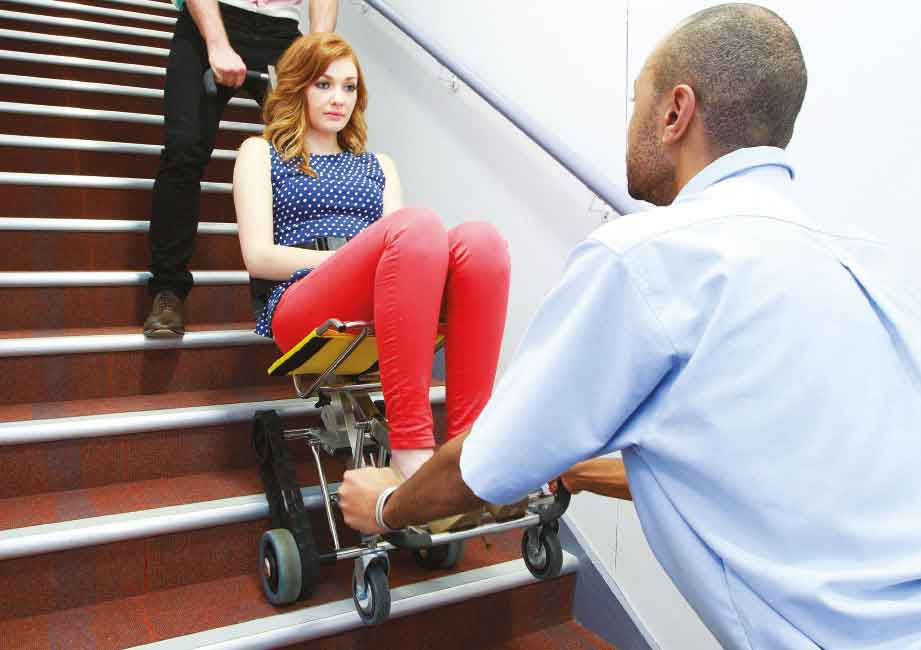
Meaning
Despite several decades of anti-discrimination legislation and updated building regulations, the needs of people with a disability or mobility impairment are still often overlooked in emergency response planning. According to a 2017 review by the Australian Safety and Compensation Council, a third to half of the people with a disability are not receiving the safety accommodations they need at work. Those accommodations that have been made mainly relate to access, rather than safety.
Consider individual needs
Under section 43 of the WHS Regulation and section 21 OH&S Act, your organisation’s emergency plan must include a Personal Emergency Evacuation Plan (PEEP) for any employee who has either a temporary or permanent mobility impairment.
Preparing an evacuation plan can be a simple process. A key is a consultative approach. It’s critical to get the plan right, not only to protect the safety of your employee but their dignity as well. There have been cases where a lack of an appropriate plan has resulted in discrimination, including during practice drills. Not having a personal emergency evacuation plan can potentially put employees in greater danger. It can also affect their sense of self-worth.
The basic definition of ‘mobility impaired’ is taken from the Queensland Regulations and is essential – any person who requires assistance to evacuate. This may mean a lack of strength to walk, grasp or lift objects. An person with a mobility impairment may use an aid, such as a wheelchair or crutches to help them function at work, but in an emergency, they will need further personal assistance to evacuate. Mobility impairment can also cover non-permanent situations, such as pregnancy or a short- term injury or illness that may affect a person’s ability to evacuate without assistance.
Each PEEP (Personal Emergency Evacuation Plan) will be dependent on the needs of the person with a disability or mobility impairment. But don’t make the mistake of assuming you know what they need based on your knowledge of their condition. The person themselves will know their own capacity and what they will need in an emergency. The best approach to ensure these needs are met is to discuss and develop the PEEP with each individual. You will also need to consider the building, the nature of the emergency, as well as the availability and capability of trained personnel to help in an evacuation. This should be done with the person, their line manager or supervisor (if appropriate) and with the building Chief Warden.
Provide a safe refuge
Your personal emergency evacuation plan (PEEP) must also identify a safe refuge area. This is a location in a building designed to hold occupants during a fire or other emergency, when evacuation may not be safe or possible.
High-rise buildings can create particular challenges for mobility-impaired employees. Fire-isolated stairwells are commonly used as refuge areas, but this refuge area must be large enough for a person in a wheelchair to turn around, as well as provide room for at least one other staff member to remain until rescue personnel arrive, without blocking the exit for other evacuating occupants.
At the very least, a PEEP should provide instruction on where to go and where to safely wait for further assistance. The importance of all stakeholders being aware of an existing PEEP is paramount to supporting the safe collection and egress assistance in an emergency.
Practising the evacuation
A properly devised PEEP that is communicated to emergency wardens and emergency personnel, will help ensure the person with mobility impairment gets the right help at the right time.
While team members are likely to want to help a mobility-impaired person evacuate in an emergency, it is important to realise that this is not the intent of the PEEP. In some cases, a person may be able to evacuate with limited assistance. In others, they may require greater physical intervention. A PEEP is designed to capture this information and promote having a plan before the event, not after when it is too late. It’s also risky to assume your staff will know how to help a mobility-impaired person in an emergency.
Regular drills and emergency training that includes practice evacuating people with any mobility impairment is essential and can help save lives in a real emergency. Despite a greater awareness of the access needs for people with a disability, in many cases, their needs have been overlooked in emergency response planning. It’s critical that emergency procedures consider the individual needs of all employees, including those with a disability or mobility impairment.
For advice on developing your emergency management plan and PEEP, contact us today.
Comments